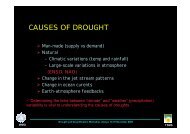Slayt 1 - RTC, Regional Training Centre - Turkey
Slayt 1 - RTC, Regional Training Centre - Turkey
Slayt 1 - RTC, Regional Training Centre - Turkey
You also want an ePaper? Increase the reach of your titles
YUMPU automatically turns print PDFs into web optimized ePapers that Google loves.
Non-Hydrostatic Models In addition, to account for vertical motions and buoyancy properly, nonhydrostaticmodels must include a great deal of detail about cloud andprecipitation processes in their temperature and moisture forecast equations.Since hydrostatic models do not have a vertical motion forecast equation, noneof these processes can directly affect the vertical motion in their predictions. One disadvantage of non-hydrostatic models is longer computation time. Sincethe models must finish running in time for forecasters to use model products,hydrostatic models are more advantageous unless non-hydrostatic phenomenaneed to be simulated or unless resolution finer than around 10 km is needed. Non-hydrostatic models run at very high resolution characteristically predictdetailed mesoscale structure and associated forecast impacts on surroundingareas. For instance, a prediction of a mesoscale convective system will include awell-defined gust front, downstream thick anvil affecting surface temperature,and trailing mesohigh affecting winds for some distance from the activeconvection. These details will look like the kinds of features observed in realconvective systems, but the forecast of convective initiation is subject toconsiderable error, possibly throwing off the whole forecast. Generally,mesoscale detail is most reliably predicted when forced by topography orcoastlines. Otherwise, the detailed structure gives an idea of what to expect ifthe weather event causing it develops, but the timing and placement of thatevent may have considerable error.
















